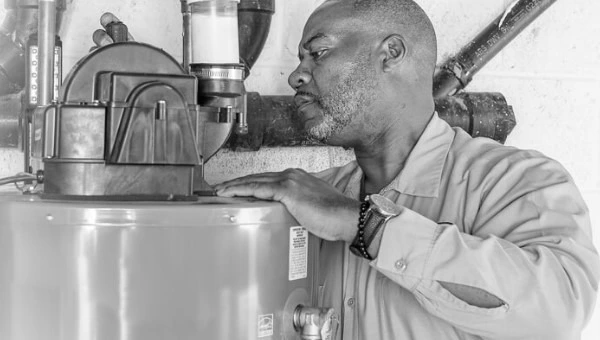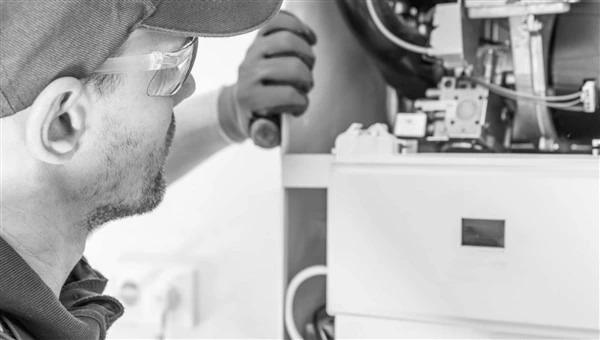Deciding on the right water heater installation for your home can be quite a conundrum, particularly for new homeowners unfamiliar with the complex world of plumbing systems. This blog post aims to simplify the process and guide you through each step, helping you make a well-informed decision that suits both your needs and budget.
Table of Contents
Introduction to Water Heater Installation
Installing a water heater is an intricate task that involves more than just connecting a few pipes and wires. It requires a detailed understanding of both the unit itself and the specific needs of the household. Proper installation is not just about getting the water hot; it’s about ensuring efficiency, safety, and longevity. The selection of the right type of water heater, the accuracy in connections, and adherence to local codes all play critical roles in this process.
From tankless models to traditional tank units, each type of water heater comes with its own set of installation requirements. These differences can significantly impact both the immediate performance of the unit and its long-term reliability. Inadequate installation can result in frequent breakdowns, higher energy bills, and even safety risks, such as electrical hazards or water damage. Therefore, understanding the complexity of water heater installation is vital for achieving optimal performance and avoiding common pitfalls.
The process begins with a careful assessment of the household’s hot water needs, which influences the choice of the unit. Then comes the precise execution of plumbing and electrical connections, followed by thorough testing to ensure everything is working as it should. Each step demands careful planning and execution to avoid future issues.
Whether tackling this task independently or hiring a professional, it is essential to approach water heater installation with a clear understanding of what it entails. This preparation can mean the difference between a smoothly operating system and a series of ongoing problems. Therefore, investing time and effort into proper installation practices is essential for the comfort and safety of everyone in the household.
Common Mistake 1: Incorrect Sizing
Choosing the wrong size water heater is a frequent mistake that can lead to various issues. A unit that’s too small will struggle to meet the household’s hot water needs, causing frustration and discomfort. Conversely, an oversized heater wastes energy, leading to higher utility bills as it works unnecessarily hard to maintain water temperatures.
To accurately size a water heater, consider the number of people in your home and their hot water usage patterns. For tank models, the first-hour rating (FHR) indicates how much hot water the unit can deliver in an hour of peak usage. For tankless models, the flow rate measures how many gallons per minute the unit can heat. These metrics are essential for matching the water heater’s capacity to your household’s needs.
Many homeowners overlook these critical metrics and rely solely on rough estimates or outdated advice, which can result in suboptimal performance. Utilizing online calculators or consulting a professional can provide more accurate guidance tailored to your specific situation. Additionally, understanding these measurements can help you make informed decisions when comparing different water heater models.
Installing an incorrectly sized unit can also shorten the lifespan of the water heater. A unit that’s too small will be overworked, leading to quicker wear and tear. On the other hand, an oversized unit will cycle on and off more frequently, which can also cause premature failure.
By taking the time to accurately determine the correct size, you can ensure your water heater operates efficiently and meets your household’s hot water demands. This attention to detail not only improves performance but also extends the life of the unit, providing better value for your investment.
Common Mistake 2: Faulty Connections
Faulty plumbing and electrical connections are major pitfalls in water heater installation, and they can have serious consequences. Poorly executed plumbing connections may lead to leaks and water damage, while incorrect electrical connections can pose significant safety risks, including fire hazards.
When it comes to plumbing, using the right type of pipe and fittings is essential. Different water heater models require specific materials, and improper choices can lead to incompatibility and leaks. It is also crucial to correctly seal all joints to ensure there are no gaps that could allow water to escape. Tightening connections too much or too little can both be problematic, so it’s important to follow the manufacturer’s guidelines precisely.
Electrical connections demand equal care and precision. Each water heater has specific voltage and grounding requirements that must be adhered to for safe operation. Failing to follow these requirements can result in electrical shorts or even fires. Always ensure that the unit is properly grounded and that all wiring is up to code. This includes using the correct gauge wire and ensuring all connections are secure.
The best way to avoid these issues is to hire a licensed professional who is well-versed in local building codes and manufacturer specifications. Professionals have the experience and tools to make sure that all connections are done safely and correctly. For those who choose to undertake the installation themselves, it is essential to meticulously follow all instructions and double-check each connection.
Even minor mistakes in plumbing or electrical connections can lead to significant problems down the line, so attention to detail is paramount in this critical aspect of water heater installation.
Water Heater Troubleshooting Tips
So, your water heater’s acting up and you’re left with cold showers? Don’t sweat it! Let’s troubleshoot some common hiccups that could be causing the problem.
No Hot Water: This one’s a bummer, but often it’s an easy fix. For electric units, check if the circuit breaker has tripped or if the thermostat needs adjustment. For gas heaters, the culprit could be a blown-out pilot light. A quick relight might just do the trick!
Water Too Hot or Too Cold: Goldilocks had it right—nobody wants water that’s too hot or too cold. If your water is scalding, lower the thermostat settings a notch or two. On the flip side, if it’s icy, crank that thermostat up a bit.
Leaky Tank: A leaky tank is like a ticking time bomb. First, ensure all connections and valves are snug. If you still spot drips, you might need to replace a worn-out valve or gasket. If the tank itself is leaking, well, it’s probably time for a new heater.
Sediment Buildup: Hard water can leave behind mineral deposits that settle at the bottom of your tank, causing all sorts of mischief. Regularly draining the tank helps flush out these pesky sediments. Trust me, your heater will thank you!
Strange Noises: Clanks, bangs, and pops coming from your water heater can be unnerving. Often, this is caused by sediment buildup, which creates air pockets that pop as the water heats. A good flush can usually clear this up.
Inconsistent Temperature: If your water temperature fluctuates like the stock market, your thermostat might be on the fritz. Check for any visible signs of damage and replace it if necessary.
Smelly Water: If your hot water smells like rotten eggs, you might have bacteria in the tank. A hydrogen peroxide flush can help sanitize the system. For chronic issues, consider replacing the anode rod with a zinc-alloy one.
Discolored Water: Rust-colored water could mean your tank is corroding from the inside out. Check the anode rod, which helps prevent rust. If it’s corroded, replace it. If rust persists, your tank might be nearing its final days.
Low Water Pressure: Mineral deposits or sediment buildup can clog your water lines, leading to low pressure. Flush the tank and clean any clogged lines to restore full flow.
Pilot Light Keeps Going Out: If your gas heater’s pilot light won’t stay lit, the thermocouple might be faulty. This small device senses whether the pilot light is on and turns off the gas if it’s not.
Guide to Water Heater Repair
Alright, you’ve got a water heater that’s decided to go on the fritz. Do you roll up your sleeves and dive into DIY territory, or is it time to call in the cavalry? Let’s break it down!
DIY Repairs:
So, you fancy yourself a bit of a handyman or handywoman? Here are a couple of common issues you can tackle on your own:
1. Heating Elements or Thermostats: Is the water not as hot as it used to be? The heating elements or thermostats could be to blame. Replacing these is generally a straightforward task—like swapping out batteries in a remote, but a tad more involved. Make sure you’ve cut off the power supply before diving in!
2. Minor Leaks at Connections: Got a little drip-drip situation going on? Leaks at pipe connections can often be handled with some plumber’s tape or sealant. Tighten up those connections and apply the tape for a snug, leak-free fit. Easy-peasy!
3. Anode Rod Replacement: If you’re dealing with smelly or discolored water, it might be time to replace the anode rod. This sacrificial rod helps prevent rust in your tank. Think of it as your water heater’s best friend that takes all the hits so the tank doesn’t have to.
When to Call in the Pros:
Some jobs are best left to those who’ve made a career out of saving the day. Here’s when you should definitely pick up the phone:
1. Gas Leaks: Smell gas? Don’t mess around—call a professional immediately. Gas leaks are dangerous and should be handled by certified technicians. Your safety is paramount, folks.
2. Internal Tank Leaks: If your tank is leaking, it’s often a sign that the inner lining has corroded. This isn’t a job for your average DIYer. A pro can assess the situation and recommend whether it’s time for a replacement.
3. Complex Electrical Issues: When it comes to electrical components, it’s sometimes best to let an electrician handle the trickier bits. Messing around with electricity can be hazardous, especially if you’re unsure of what you’re doing.
4. Persistent Problems: If you’ve tried all the quick fixes and your water heater still isn’t cooperating, it’s time to call in a pro. Persistent issues could indicate a bigger problem that needs a professional touch.
Pro Tips:
– Keep your user manual handy. It’s a treasure trove of useful information for DIY repairs and can guide you through the process.
– Always remember to cut off the power or gas supply before starting any repair work.
Calculating Water Heater Cost
Let’s talk money! Installing a new water heater is a fantastic investment, but it’s always good to know what you’re getting into financially. Here’s the lowdown on what you can expect to spend.
– Tank Water Heaters: These are your traditional workhorses and tend to be kinder on the wallet upfront. You’re looking at a range of $900 to $1,000 for the unit itself. Don’t forget the installation fee, which can set you back another $500 to $1,000 or so, depending on your locale and the complexity of the job.
– Tankless Water Heaters: These sleek, on-demand units come with a higher price tag, typically between $1,000 and $2,000. Installation can also be pricier, sometimes adding up to $2,000 or more, thanks to the additional plumbing and electrical work required. But hey, you’re paying for efficiency and space-saving!
Once you’ve tackled the initial outlay, it’s time to consider the ongoing costs. Like a pet, a water heater requires a bit of upkeep.
– Energy Bills: Tankless heaters generally cost less to operate since they only heat water when you need it. Tank heaters, on the other hand, keep a reservoir of hot water ready, which can mean higher energy use. Keep an eye on that monthly bill!
– Maintenance: Regardless of the type, all water heaters benefit from regular TLC. Expect to shell out for periodic inspections and minor repairs. A little maintenance can go a long way in preventing bigger, costlier issues down the road.
Don’t overlook potential savings that might offset some of these costs. For instance:
– Rebates and Tax Credits: Many energy-efficient models qualify for state or federal rebates. It’s like getting paid to be eco-friendly!
– Reduced Utility Bills: Investing in an energy-efficient model can lower your utility bills over time. Sure, the upfront cost is steeper, but think of the long-term savings as the cherry on top.
When budgeting, also factor in any necessary upgrades to your home’s plumbing or electrical systems. If you’re switching from a tank to a tankless system, you might need to update your gas lines or electrical wiring, adding to the initial expense.
So there you have it, folks! Knowing the costs upfront helps you budget smarter and ensures you pick the best water heater for your needs and wallet.
Maximizing Water Heater Lifespan
Want your water heater to stick around for the long haul? With a bit of TLC, you can make it happen! Let’s dive into some handy tips to keep your heater in tip-top shape.
– Regular Inspections: Give your heater a once-over every few months. Look out for leaks, rust, or any signs of corrosion. It’s like a health check-up, but for your water heater!
– Flushing the Tank: Sediment buildup is the enemy. Draining and flushing your tank annually can help keep those nasty minerals at bay. It’s a bit of a chore, but your heater will thank you with years of reliable service.
– Anode Rod Check: This unsung hero sacrifices itself to prevent rust inside your tank. Every couple of years, take a peek. If it’s more corroded than a pirate’s treasure chest, it’s time to swap it out.
– Age: Is your heater hitting its golden years? Most units last about 8-12 years. If yours is in that range, start saving up for a replacement.
– Frequent Repairs: If you’re calling the repairman more often than your mom, it might be time to let go. Multiple repairs can add up, making a new unit a more economical choice.
– Loss of Efficiency: If your heater is working harder but delivering less, it’s probably not earning its keep. Higher energy bills and inconsistent water temperatures are a sure sign your heater is ready to retire.
– Check the Pressure Valve: This little guy prevents your tank from turning into a pressure cooker. Ensure it’s working correctly by lifting the valve’s lever and letting it snap back. A quick burst of water means it’s doing its job.
– Insulate the Heater: Wrap your tank in an insulating blanket to keep the heat in and the cold out. Think of it as a cozy winter coat for your water heater.
– Monitor Water Temperature: Setting your thermostat to 120°F is the sweet spot. It’s hot enough for comfort but not so hot that it scalds or wastes energy.
There you have it! With these easy-peasy steps, you can keep your water heater running smoothly and extend its lifespan, all while saving a few bucks along the way. Now go on, give that trusty appliance the love it deserves!
Essential Water Heater Maintenance
Alright, let’s get down to the nitty-gritty of keeping your water heater in top shape. Think of it like giving your trusty steed a little TLC to keep it galloping smoothly for years to come!
– Pressure Valve Check: Your water heater’s pressure valve is like its safety net. Lift the lever, let it snap back, and if you see a quick burst of water, you’re good to go. No water? It’s time for a new valve. This little check can prevent a lot of future headaches.
– Wrap It Up: Think of your water heater as a cozy burrito. By insulating it with a blanket, you help retain heat and improve efficiency. It’s an easy way to cut down on energy costs and keep things running smoothly.
– Temperature Settings: Here’s the sweet spot—120°F. It’s hot enough for a luxurious shower but not so hot that it’ll scald you or spike your energy bill. Plus, it helps prevent sediment buildup inside the tank.
– Flush the Tank: Sediment is like that uninvited guest who overstays their welcome. Once a year, drain and flush the tank to get rid of any accumulated gunk. Your heater will thank you with better performance and a longer lifespan.
– Anode Rod Inspection: Every couple of years, check the anode rod. It’s your heater’s sacrificial lamb, preventing rust from taking over. If it looks more gnarly than a pirate’s peg leg, replace it. Your tank will stay rust-free and efficient.
– Look and Listen: Make it a habit to visually inspect your heater for any signs of leaks or rust. While you’re at it, listen for any unusual noises. Clanks and bangs could mean sediment buildup, which a good flush can usually fix.
– Professional Tune-Up: While you can handle most maintenance tasks, a professional inspection every couple of years is a smart move. They’ll catch any potential issues before they become full-blown problems.
So there you have it, folks! With these straightforward tips, you can keep your water heater humming along happily for years. Show it some love, and it’ll reward you with hot showers and lower energy bills. Now go forth and be the water heater whisperer you were always meant to be!
Conclusion
At our company, we hold ourselves to the highest standards of quality, meticulously ensuring that each project is completed in accordance with industry requirements and regulations while keeping costs affordable for our clientele. By choosing Christian Plumbing Services for your plumbing needs, you are making a decision to prioritize excellence and professionalism. Our unwavering dedication to delivering top-tier outcomes means that every task, no matter how big or small, is executed with precision and care to yield outstanding results. Rest assured that partnering with us will lead to a seamless and satisfactory experience, as we take pride in our ability to consistently exceed expectations and leave our customers fully satisfied with the services rendered.
FAQs
How much is a new water heater for a house?
The cost of a new water heater for a house in Clovis, CA can vary greatly depending on the size and type of water heater you choose. Standard tank-style electric water heaters may range from $1,500 to roughly $2,000, while gas models could cost between approximately $2,000 and around $2,500. Tankless water heaters are more expensive upfront but offer significant energy savings over time; these units usually range from $3,000 to as much as $4,000 or more.
How often should water heaters be replaced?
Water heaters should be replaced every 10 to 12 years, depending on the type of water heater and its usage. This is because over time, water heaters can become corroded or suffer from mineral buildup that can reduce their efficiency and lead to costly repairs. Furthermore, modern water heaters are often more efficient than earlier models, thus providing an opportunity to economize in the long run through substitution of an aged unit.
What is the number one water heater brand?
The companies Bradford White, Rheem, Rinnai, Navien, Stiebel Eltron, and A. O. Smith, are among the most prominent producers of hot water heaters now available on the market. These businesses are well-known for the high-quality items and inventive designs that they produce in order to meet the requirements of their customers.






